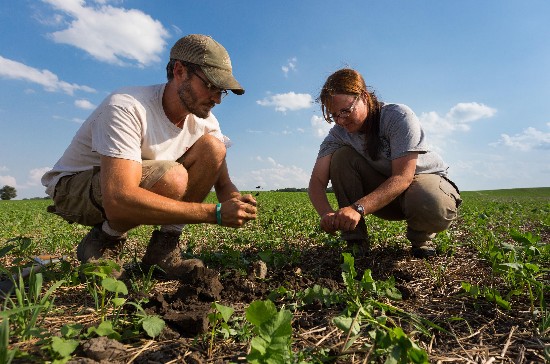Canada’s federal government recently announced a three-year $200 million CDN fund to help farmers store carbon through the implementation of agricultural practices that have always been around but never seen as useful to fight global warming. The pot of money is part of Canada’s Agricultural Climate Solutions Initiative and included within a $4 billion Natural Climate Solutions Fund.
Farmers applying for the money need to demonstrate their ability to sequester carbon and reduce greenhouse gas (GHG) emissions in three specific areas:
- Managing nitrogen by reducing fertilizer usage that contributes to surface and groundwater contamination.
- Using cover cropping by planting non-harvested winter cover crops and introducing intercropping, multiple cropping practices that involve growing two or more crops in proximity.
- Moving to rotational grazing where livestock is moved to different land segments to allow for grassland regeneration.
Farmers need to show data to prove GHGs are being reduced and carbon is being sequestered.
The European Union (EU) is following Canada’s initiative closely recognizing the GHG contribution made by the agricultural sector needs to be addressed in combatting climate change. The EU established a Climate Target Plan for 2030 that includes carbon farming among its programs. But it has yet to figure out how to structure the money side of it to get farmers to adopt carbon-storing and GHG reduction strategies. The Canadian system of direct payments could prove to be the model the continent adopts, or not.
In April of this year, the European Commission published its technical guide for carbon farming. EU member states were invited to introduce common agricultural policies that included a rollout of carbon farming. The amount of financial opportunity for farmers the Commission estimated to be worth between €38 and 58 billion.
Among the EU community, Eire is looking at a hybrid model for carbon farming that mixes carbon credits and cash payouts. In a recent interview conducted by The Irish Examiner, Agriculture Minister, Charlie McConalogue stated his department was launching a pilot program for on-farm carbon trading using the National Soil Sampling Programme to collect data for a baseline to assess progress. McConalogue suggested that the existing Woodland Environment Fund in Eire which uses carbon credits could be an alternative to the Canadian cash payment model. The pilot project in Eire is just one of a number being instituted within the EU.
None of these programs and initiatives address the emissions elephant in the room: enteric fermentation, responsible for a significant amount of GHGs from farming. Beef cattle are the culprits and it is their “cow farts,” that release significant amounts of methane (CH4), a far more potent GHG than carbon dioxide (CO2).
How to address the meat issue in a world where there is a rising demand particularly in the Developing World is particularly challenging. Three approaches immediately come to mind.
- If we were all to reduce beef consumption then we would need less livestock which would decrease GHGs. In the Developed World, rising numbers of people becoming vegetarians is a movement associated with personal climate change initiatives. Physicians argue that a switch to a low meat diet has significant health benefits. So more meatless days here in North America and in Europe could be a way to combat chronic diseases and medical conditions associated with lifestyle and diet. The added bonus will be a personal contribution to GHG reductions. But it wouldn’t address the rise in meat demand in the Developing World.
- There is the growing business of cultured meat which is an industrial process that turns cells from living animals into meat products. Once considered prohibitively expensive, and largely a laboratory experiment, cultured meat is now starting to appear in groceries in North America and Europe. Organizations focused on the ethical treatment of animals who don’t profess to be vegetarian or vegan-focused are keen to see cultured meat replace livestock as a food source.
- There are experiments focused on changing animal feeds for livestock to reduce CH4 emissions. In a recently published study out of the University of California, Davis, adding seaweed to cattle diets reduced CH4 emissions by 82%. Seen as a way to continue to produce beef and dairy products to feed the world, it also considers that a significant amount of farmland is unsuitable for growing food crops. In a university press release, Ermias Kebreab, professor and Sesnon Endowed Chair of the Department of Animal Science and Director of the World Food Center makes this observation stating “much more land is suitable only for grazing, so livestock plays a vital role in feeding the 10 billion people who will soon inhabit the planet.” What is so magical about seaweed in a cow’s diet? Apparently, it inhibits an enzyme in the digestive system responsible for producing CH4. And you don’t need the cattle to eat a lot of it, just a small amount per day is enough to reduce climate-change causing emissions. The seaweed in the feed study was Asparagopsis taxiformis (AT), a form of red algae found in tropical to mid-latitude ocean waters. In the U.S. where many ranches are well away from the ocean, seaweed as a feed is a little more challenging than it is for university researchers at a California site within a stone’s throw of the Pacific. But a new project considered an aquatic moonshot is out to mass-produce and distribute AT to meet future demand. Known as the Greener Grazing Project, the plan is for ocean-based cultivation of AT coming up with innovative harvesting, post-harvest processing, and distribution of the feed supplement to where the cattle are in large quantities at an affordable price.
It would be interesting to see if Canada and the EU in the near future consider livestock CH4 emission reduction strategies as part of agricultural climate solutions initiatives.
















